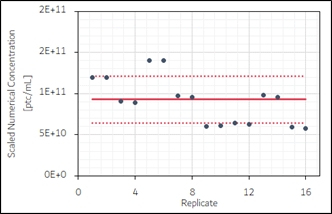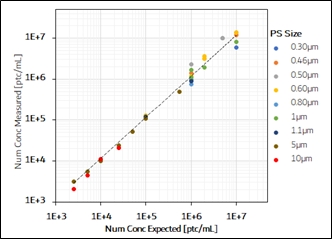Traditional technologies, as the Dynamic Light Scattering (DLS), fail at the lowest particle concentration, especially when the data acquired are affected by the presence of other components and particles cannot be distinguished by cells, proteins, and others thus ruling out their employment in the development and quality control of sample.
SPES / SPES² (Single Particle Extinction and Scatterings) take advantage of a single particle measuring approach to estimate the numerical particle concentration, improving the range of possibilities of added value information retrieved by patented SPES / SPES² methods. SPES / SPES² are capable to deliver information about the absolute and relative numerical particles concentration of the single particle population detected, being able to clearly distinguish and exclude signals caused by other objects in the surrounding medium.
The reproducibility of the estimate of numerical concentration via SPES / SPES² methods are presented in figure. Results for 16 analytical replicates of 0.7µm PS samples diluted 20000 times from an 1E11 ptc/mL bulk sample are presented.
(in figure) Reproducibility of the concentration estimations of the 16 analytical replicates of 0.7µm PS samples. Note that the concentration values are multiplied by the 20000 times dilution factor to retrieve the bulk value of the numerical particle concentration.

An estimate of the accuracy can be performed also by comparing the expected numerical concentration, based on the nominal concentration of the sample bulk and dilution done of samples of different diameters and the relative experimental measured values.
(in figure) Estimate of the accuracy of the numerical concentration analysis of the Classizer™ ONE. Polystyrene samples of different size and concentration are considered.

